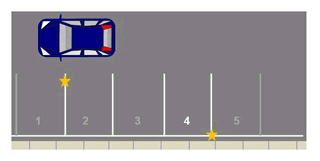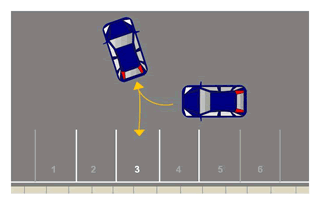Driving instructor vacancies in Basildon
- Jul 08, 2019
I n a car park, do you reverse into a parking space and drive out?
Reversing into the space provides you with several advantages.
The first of these is that it is safer to reverse into somewhere you can see into (the parking space), rather than reverse out, into somewhere you can't (the line of moving traffic). Don't start the manoeuvre if you're likely to endanger other road users.
It is also easier to control a car going forwards, rather than backwards when the car is first started and the automatic choke is activated.
From a security point of view, reversing close to an object such as a wall can make it more difficult for thieves to access your boot. If you need to exit a parking space quickly for personal security, driving out provides you with better acceleration and improved vision.
So why do most drivers tend to drive straight into a bay? There are generally two main reasons, because it seems easier and most notably, most people don't know how to reverse into a bay as the manoeuvre was only recently introduced into the driving test.
Whenever possible, park off the road or in a car park which is usually between two vehicles.
Firstly check that there is enough space for you to centre your vehicle and to provide enough room to open the doors.
Always try to park squarely in the marked space otherwise the vehicle next to you might have difficulty manoeuvring in or out of the space.
How to reverse into the space
How we actually position before starting the exercise depends on two main factors;
How busy the car park is and therefore the need to consider not inconveniencing other road users too much and:
If there is enough room to position correctly before starting the procedure.
Option 1 shows an approach to reverse into a bay to the left. You will be able to see the bay clearly over your left shoulder. Choosing this option will mean that you require less space and therefore safer.
You should also note that this option will require many of the techniques you will have already employed when reversing around a corner.
Use your mirrors and signal if necessary although do consider that you will need to drive past the space which may confuse other road users of your intentions.
Keep your speed down which will allow you the opportunity to position correctly. This should be about 1 metre (open car door length) from the end of the bay and 1 car length passed the bay that you want to reverse into(bay 4).
It is then important to effectively take all-round observation. Look out for pedestrians walking across the car park and other road users approaching. Start your observation from right shoulder to left shoulder i.e. finishing the way that you will begin to move including the mirrors.

Begin to reverse in a straight line until the rear of your vehicle has just entered the bay before the one you want. You can confirm this by seeing the very far corner of the chosen bay in the rear passenger window or/and the line of a bay will be directly in line with your seating position.
At this point, look all around again as this is the point of your turn.
Begin to move the car slowly when safe whilst turning the steering wheel briskly to turn into the bay. It is important to note that the car must be moving whilst turning the wheel to avoid dry steering.
The car will then enter the required bay neatly. Just as the car is nearing a straight course, quickly straighten the wheels in the opposite direction to straighten the car. For the benefit of moving off again, finish with your wheels straight.
Option 2 shows how to approach a bay to get a clear view in your rear window. This is the easier option, however it can only be used if you have plenty of space in front of the bay.

For this option you will need to position a little wider from the end of the bays and as you line up with the beginning of the bay before the one you require, steer away from the bays so that you finish almost directly in line with the bay you have chosen(bay 3). This will obviously depend upon the amount of space and steering you used.
At this point, look all around again, then when safe proceed slowly looking through the rear window to see the bay and potential hazards.
When doing these manoeuvres, take your time, reverse under full control, safely and steadily. Always use good, effective all-round observation and show consideration to other road users.
You should be aware that if any "shunting" (moving forwards then back again) is needed to correct your ultimate position between the lines, then it must be done BEFORE your car enters the bay.
Adjusting the near (left) side mirror.
It is OK for you to move a mirror before starting the manoeuvre, but this could cause a problem especially if you become too reliant on the mirror and forget to use all round observations. When doing this manoeuvre you have to reverse using all round observations and occasional quick glances at the side mirror for checking your position.
If lots of practice and encouragement fails to get you confidently into a bay then sometimes we would suggest moving the mirror, but keep checking all round and it is important that the mirror is returned to its usual setting before driving off.